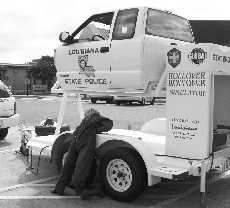Students and faculty were able to witness the effect a seat belt has on the passengers and driver of a flipping vehicle when Louisiana State Police’s Rollover Simulator came to campus Tuesday. This simulation, which was held across the street from the Family and Consumer Science building, showed how a person would react to three scenarios that can occur if in a car accident that results in vehicle that rolls over multiple times.
In order to simulate this, the police brought the cab of a police car on a trailer.
The cab was attached so it could spin in circles.
Louisiana State Police Troop C Public Information Officer, Gilbert Dardar placed a dummy in the driver’s seat of the vehicle either wearing no seat belt, incorrectly wearing a seat belt or correctly wearing a seat belt.
Dardar cranked the vehicle, which showed how the dummy reacted to flipping. The driver’s window was down during the entire simulation because if it were an actual accident the dummy would break the glass if it flew out.
“I’m glad to do it; it’s the type of thing that gets college students that don’t wear their seat belts to get an eye-opening experience,” Dardar said.
The first scenario is wearing no seat belt at all. According to the National Highway Traffic Safety Administration, 20 percent of unrestrained passenger’s occupants are ejected for a vehicle and overall 63 percent of people killed in car accidents are not wearing seat belts.
With the simulator, the dummy propelled out of the cab and landed hard onto the concrete.
The next scenario was wearing a seat belt improperly.
According to Dardar, if you are wearing a seat belt incorrectly, it is as though you are not wearing one.
When the dummy was spun with its seat belt on incorrectly, its body was thrown out of the car with the exception of the left arm, which was trapped inside the vehicle. As the vehicle rolled over more and more, the dummy was violently tossed around, slamming its entire body to the vehicle countless times.
The final scenario showed that dummy rolling over with its seat belt on correctly. The NHTSA says that safety belts, when used correctly, reduce the risk of fatal injury to front-seat passenger car occupants by 45 percent. From 1975 through 1999, an estimated 123,213 lives were saved by safety belts. Seat belts prevent one from being thrown from the car.
In the simulation, although being tossed inside the vehicle, the dummy stayed inside the cab.
Michael Gautreaux, professor for safety technology and adviser for the student ASSE chapter at Nicholls, said, “Motor vehicle accidents are the number one cause of death in the United States; it usually involves alcohol as well. Study after study shows that wearing a seat belt can save your life so we are just trying to increase awareness in the University.”
According to the NHTSA’s Traffic Safety Facts Overview of 2001, in the past 26 years, safety belts prevented 135,000 fatalities and 3.8 million injuries, saving $585 billion in medical and other costs. If all vehicle occupants had used safety belts during that period, nearly 315,000 deaths and 5.2 million injuries could have been prevented – and $913 billion in costs saved.
“It’s important for students to see this simulation and the visual picture that it provides. It is a good learning tool, more so than just reading or hearing about it,” Gautreaux said.
President of the Student Chapter, Rene Vidrine, said, “We expected more to come to the simulation, but this was our first try.”
ASSE plans to host another simulation at the end of this semester.








